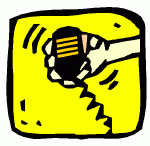 I happened upon this posting from Hans PD0AC about the Baofeng UV-B5 handheld transceiver. Hans has written a number of useful reviews on the El Cheapo Radios from China, so when he wrote “The Baofeng UV-B5 is close to perfect”, it caught my attention. I have a couple of the other radios from China that I blogged about here and here.
I happened upon this posting from Hans PD0AC about the Baofeng UV-B5 handheld transceiver. Hans has written a number of useful reviews on the El Cheapo Radios from China, so when he wrote “The Baofeng UV-B5 is close to perfect”, it caught my attention. I have a couple of the other radios from China that I blogged about here and here.
I ordered one of the radios from 409shop for $53 including shipping from Hong Kong, and it arrived a few days ago. After playing with it a bit, I downloaded the free programming software and loaded up a few frequencies. The software was a huge improvement over the crapware that came with the UV-5R…it installed easily and seems to work just fine.
I did an initial performance check with my HP 8920A RF Test Set and found the performance to be quite good:
VHF - transmit frequency error ~50 Hz
transmit power 4.4W
fm deviation ~4.5 to 5 kHz
receive sensitivity ~0.2 uV
UHF - transmit frequency error ~170 Hz
transmit power 4.4 W
fm deviation ~4.5 to 5 kHz
receive sensitivity ~0.2 uV
I’ve noticed poor harmonic distortion on a few Baofeng radios, so I checked that out. On VHF, the harmonics are about -55 dBc, which is good. I did not check UHF but typically these radios have had better harmonic performance on the UHF band. Hans PD0AC reported similar measured results.
On the air testing resulted in excellent signal reports in terms of audio quality. The received audio is also loud and clear. The user manual is acceptable….mostly clear English but it does have some difficult-to-understand sentences here and there. Like the other radios from China, you’re really going to want to use the programming software to set things up. After that, the controls are quite usable.
Note that, unlike some of the other radios from China, the UV-B5 is not certified for Part 90 use. At least not yet.
A Yahoo group has sprung up to discuss this radio and share information, so check that out.
My overall assessment is that Baofeng has cleaned up the issues with the UV-5R (and don’t forget, I really like that radio!). The UV-B5 is a sweet little radio that will make a splash when it hits the US market.
73, Bob K0NR


















